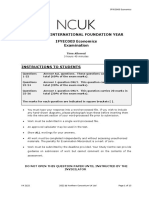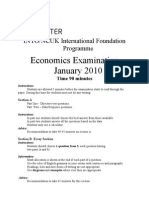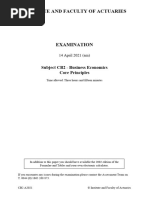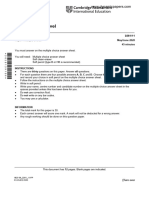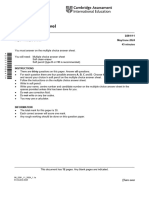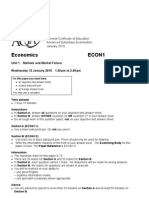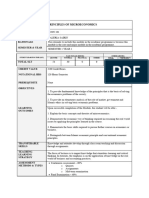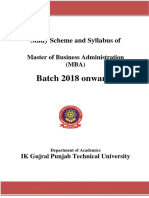EoS1 2021 V1
EoS1 2021 V1
Uploaded by
691922029Copyright:
Available Formats
EoS1 2021 V1
EoS1 2021 V1
Uploaded by
691922029Copyright
Available Formats
Share this document
Did you find this document useful?
Is this content inappropriate?
Copyright:
Available Formats
EoS1 2021 V1
EoS1 2021 V1
Uploaded by
691922029Copyright:
Available Formats
IFYEC002 Economics
THE NCUK INTERNATIONAL FOUNDATION YEAR
IFYEC002 Economics
End of Semester 1 Test
2020-21
Test Session Time Allowed
Semester One 2 hours 40 minutes
INSTRUCTIONS TO STUDENTS
1
SECTION A Answer ALL questions. This section carries 20 marks.
SECTION B Answer 1 question ONLY. This section carries 30 marks.
The marks for each question are indicated in square brackets [ ].
• Work must be submitted in a single word-processed file.
• You must type your response into a word-processed file. If you wish to include
any hand-drawn diagrams, please photograph/scan these before inserting them
into the relevant section of your word-processed file prior to submission.
• All work must be completed independently. The penalty for collusion is a mark
of zero.
• You may use external sources of information but must ensure you reference
these. Plagiarism is a form of academic misconduct and will be penalised.
• Work must be submitted by the deadline provided. Your Study Centre can be
contacted only for guidance on submission of work and cannot comment on the
contents of the assessment.
V1 2021 © 2021 Northern Consortium UK Ltd Page 1 of 8
IFYEC002 Economics
Section A
Answer ALL questions.
This section carries 20 marks.
Questions A1 – A10: select either A, B, C or D and write this as your answer.
Question A1
The diagram below shows costs and revenues for a firm. [1]
Cost /
Revenue
AC
MC
AR
A B C D Output
0
MR
A firm making normal profit will produce at output level
A A
B B
C C
D D
Question A2
All other things being equal, which of the following would shift a firm’s demand [1]
curve to the right?
A A rise in supply.
B A rise in wages for workers involved in the production of the good.
C A fall in price.
D A rise in the price of a substitute good.
V1 2021 © 2021 Northern Consortium UK Ltd Page 2 of 8
IFYEC002 Economics
Question A3
The diagram below shows the production possibility frontier (PPF) for a farmer [1]
with the option of growing two different types of crop – sugar and maize.
Sugar
PPF1 A
B
PPF2
Maize
Over time, following an expansion of resources and improvements in capital,
the PPF for the farmer moves from PPF1 to PPF2, and production also moves
from Point A to Point B.
From the diagram, it can be concluded that
A Point A is productively inefficient when producing on PPF1.
B there is under-utilisation of resources at Point B.
C the production of maize is more profitable than the production of sugar
D The opportunity cost of producing sugar is zero.
Question A4
A firm discovers that there is an income elasticity of demand of -0.8 for its [1]
product. It is most likely that
A it sells inferior goods.
B it also has a positive price elasticity of demand.
C the firm is making losses.
D has a high likelihood of being the subject of a takeover from a rival
firm.
V1 2021 © 2021 Northern Consortium UK Ltd Page 3 of 8
IFYEC002 Economics
Question A5
In the short-run, diminishing returns occurs when [1]
A the firm is getting smaller.
B marginal revenue is rising
C average revenue is falling.
D output is rising but at a falling rate.
Question A6
Which of the following is NOT a characteristic of oligopolistic competition? [1]
A Independent decision making on prices
B High barriers to entry
C Incentives to collude
D Non-price competition
Question A7
Average fixed costs will always [1]
A remain constant with output.
B fall as prices increase.
C rise when output falls.
D rise in direct proportion to profits.
Question A8
Look at the following two statements [1]
Statement 1: “Last year, inflation was 0.5% which was too low.”
Statement 2: “Last year, unemployment was 6.8% which was too high.”
From the two statements we can conclude that
A statement 1 is positive, and statement 2 is normative.
B both statements are normative.
C both statements are positive.
D statement 1 is normative and statement 2 is positive.
V1 2021 © 2021 Northern Consortium UK Ltd Page 4 of 8
IFYEC002 Economics
Question A9
The diagram below shows the market demand and supply curves for a good [1]
that creates a negative externality in production.
Price
A B
P2
P1 E
F
P3 C
D
0
Q* Q** Quantity
Due to the negative externalities created, the government wishes to
discourage the production of the good. Therefore, it could
A Impose a maximum price at P2.
B Impose a tax equivalent to the distance AB.
C Give a subsidy equivalent to the distance BC.
D Impose a tax equivalent to the distance AD.
Question A10
Which of the following is most likely to lead to a supermarket manufacturer [1]
benefiting from internal economies of scale?
A An increase in the size of the manufacturing plant.
B Hiring lower skilled labour.
C Sourcing new suppliers that are more expensive but sell more ethically
produced food.
D Relocation to an area where it can take advantage of improved road
and infrastructure networks.
Section A continues on the following page.
V1 2021 © 2021 Northern Consortium UK Ltd Page 5 of 8
IFYEC002 Economics
Question A11
HP scores $176m win in CD-ROM drive price-fix case
HP have won a six-year court case against suppliers that it accused of price-
fixing, with a jury in Texas awarding $176m to the US computer giant.
Back in October 2013, HP accused seven oligopoly manufacturers of optical
disc drives – Toshiba, Samsung, Sony, NEC, Panasonic, TEAC, and Quanta –
of colluding together in order to get HP to pay more than a fair market rate
for the equipment.
HP had set up an online bidding platform for suppliers of the optical drives –
e.g. CD-ROM, CD-R/RW, Blu-ray, DVD, and similar drives – with the goal of
getting a good price for bulk purchases.
But rather than this causing the companies to compete with one another on
price, they colluded together to force HP to pay more for CD-ROMs. The
case went on for years, and as evidence mounted that HP’s suspicions were
correct, one after another, the suppliers settled for undisclosed amounts.
HP had been concerned for a long time it was the victim of price fixing and
complained about “billions of dollars of purchases of optical disk drives at
artificially inflated prices over several years.”
Source: theregister.co.uk (adapted extract)
(a) Define the term “oligopoly” [1]
(b) As a result of the behaviour of the seven firms involved, HP had [3]
argued that they were effectively acting as a monopoly. Demonstrate
on a diagram the abnormal profit that might have been achieved by
the firms involved.
(c) Using a simple example, briefly explain the concept of game theory. [3]
(d) State THREE possible causes of oligopoly power in the market for [3]
computer components.
Section B begins on the following page.
V1 2021 © 2021 Northern Consortium UK Ltd Page 6 of 8
IFYEC002 Economics
Section B
Answer ONE question only.
This section carries 30 marks.
• You must answer 1 complete question.
• Each question has two parts, (a) and (b). Both parts must be answered for the
question you choose.
• For all questions, you may use diagrams to help illustrate your answer.
Question B1
(a) Landfill tax was first introduced in the UK in October 1996 to [10]
encourage waste producers and the waste management industry to
switch to more sustainable alternatives for disposing of material. In
2019, the landfill tax rate was increased from £88.95 per tonne to
£91.35 per tonne in the hope this would encourage more firms to
minimise the materials they use that create waste, or switch to using
materials that can be recycled.
With the aid of a diagram, analyse the likely economic impact of such
a tax on the market for waste.
(b) Evaluate the effectiveness of such a tax on combating the negative [20]
externalities caused by the excessive dumping of waste materials.
Question B2
(a) Explain carefully the characteristics of a firm in perfect competition [10]
AND using a diagram explain the long-run equilibrium position of a
firm operating under conditions of perfect competition.
(b) Evaluate the view that perfect competition is always a more desirable [20]
market structure than a monopoly.
Question B3
(a) Analyse, with the use of numerical examples, the concepts of price, [10]
income and cross elasticity of demand AND explain how price
elasticity of demand can affect a firm’s revenue.
(b) Evaluate the view that profit maximisation is always the primary [20]
objective for all firms.
- This is the end of the test –
V1 2021 © 2021 Northern Consortium UK Ltd Page 7 of 8
IFYEC002 Economics
Blank Page
V1 2021 © 2021 Northern Consortium UK Ltd Page 8 of 8
You might also like
- The Ncuk International Foundation Year: IFYEC002 EconomicsNo ratings yetThe Ncuk International Foundation Year: IFYEC002 Economics17 pages
- Question Paper Introduction To EconomicsNo ratings yetQuestion Paper Introduction To Economics24 pages
- Unit j205 01 Introduction To Economics Sample Assessment MaterialNo ratings yetUnit j205 01 Introduction To Economics Sample Assessment Material56 pages
- Gcse Economics: Paper 1 How Markets WorkNo ratings yetGcse Economics: Paper 1 How Markets Work20 pages
- MR Moyo - Economics Revision Basic Economic Problem, Resource Allocating, PPC, Money Citrusperibus, Assignment 1 AsNo ratings yetMR Moyo - Economics Revision Basic Economic Problem, Resource Allocating, PPC, Money Citrusperibus, Assignment 1 As14 pages
- Cec620s Question Paper 15 June 2019 FinalNo ratings yetCec620s Question Paper 15 June 2019 Final9 pages
- Cambridge International AS & A Level: Economics 9708/33No ratings yetCambridge International AS & A Level: Economics 9708/3312 pages
- Grade 10 - Eco - MCQ - 2020 to 2023 CopyNo ratings yetGrade 10 - Eco - MCQ - 2020 to 2023 Copy332 pages
- Cambridge Assessment International Education: EconomicsNo ratings yetCambridge Assessment International Education: Economics21 pages
- Economic Insights from Input–Output Tables for Asia and the PacificFrom EverandEconomic Insights from Input–Output Tables for Asia and the PacificNo ratings yet
- World Bank East Asia and Pacific Economic Update 2012, Volume 2: Remaining ResilientFrom EverandWorld Bank East Asia and Pacific Economic Update 2012, Volume 2: Remaining ResilientNo ratings yet
- EDELEON - SY 2023-2024 - 2nd Semester - ECON12 - Midterm ExaminationNo ratings yetEDELEON - SY 2023-2024 - 2nd Semester - ECON12 - Midterm Examination7 pages
- Managerial Economics and Business StrateNo ratings yetManagerial Economics and Business Strate15 pages
- Industrial Economics Assignment 3: - IntroductionNo ratings yetIndustrial Economics Assignment 3: - Introduction2 pages
- Competition and Oligopoly in Telecommunications Industry in The EU100% (5)Competition and Oligopoly in Telecommunications Industry in The EU18 pages
- Download Full ECON MICRO 5th Edition (eBook PDF) PDF All Chapters100% (2)Download Full ECON MICRO 5th Edition (eBook PDF) PDF All Chapters41 pages
- 001 (ECON 101) PRINCIPLES of MICROECONOMICSNo ratings yet001 (ECON 101) PRINCIPLES of MICROECONOMICS4 pages
- Managerial Economics: Economic Tools for Today’s Decision Makers, 6e 6th Edition Paul G. Keat 2024 Scribd Download100% (1)Managerial Economics: Economic Tools for Today’s Decision Makers, 6e 6th Edition Paul G. Keat 2024 Scribd Download47 pages
- Application On Game Theory: Cement Industry in Egypt - Arabian Cement CompanyNo ratings yetApplication On Game Theory: Cement Industry in Egypt - Arabian Cement Company8 pages
- Batch 2018 Onwards: Study Scheme and Syllabus ofNo ratings yetBatch 2018 Onwards: Study Scheme and Syllabus of129 pages
- The Ncuk International Foundation Year: IFYEC002 EconomicsThe Ncuk International Foundation Year: IFYEC002 Economics
- Unit j205 01 Introduction To Economics Sample Assessment MaterialUnit j205 01 Introduction To Economics Sample Assessment Material
- MR Moyo - Economics Revision Basic Economic Problem, Resource Allocating, PPC, Money Citrusperibus, Assignment 1 AsMR Moyo - Economics Revision Basic Economic Problem, Resource Allocating, PPC, Money Citrusperibus, Assignment 1 As
- Cambridge International AS & A Level: Economics 9708/33Cambridge International AS & A Level: Economics 9708/33
- Cambridge Assessment International Education: EconomicsCambridge Assessment International Education: Economics
- Exploring a Low-Carbon Development Path for VietnamFrom EverandExploring a Low-Carbon Development Path for Vietnam
- Economic Insights from Input–Output Tables for Asia and the PacificFrom EverandEconomic Insights from Input–Output Tables for Asia and the Pacific
- World Bank East Asia and Pacific Economic Update 2012, Volume 2: Remaining ResilientFrom EverandWorld Bank East Asia and Pacific Economic Update 2012, Volume 2: Remaining Resilient
- EDELEON - SY 2023-2024 - 2nd Semester - ECON12 - Midterm ExaminationEDELEON - SY 2023-2024 - 2nd Semester - ECON12 - Midterm Examination
- Competition and Oligopoly in Telecommunications Industry in The EUCompetition and Oligopoly in Telecommunications Industry in The EU
- Download Full ECON MICRO 5th Edition (eBook PDF) PDF All ChaptersDownload Full ECON MICRO 5th Edition (eBook PDF) PDF All Chapters
- Managerial Economics: Economic Tools for Today’s Decision Makers, 6e 6th Edition Paul G. Keat 2024 Scribd DownloadManagerial Economics: Economic Tools for Today’s Decision Makers, 6e 6th Edition Paul G. Keat 2024 Scribd Download
- Application On Game Theory: Cement Industry in Egypt - Arabian Cement CompanyApplication On Game Theory: Cement Industry in Egypt - Arabian Cement Company


